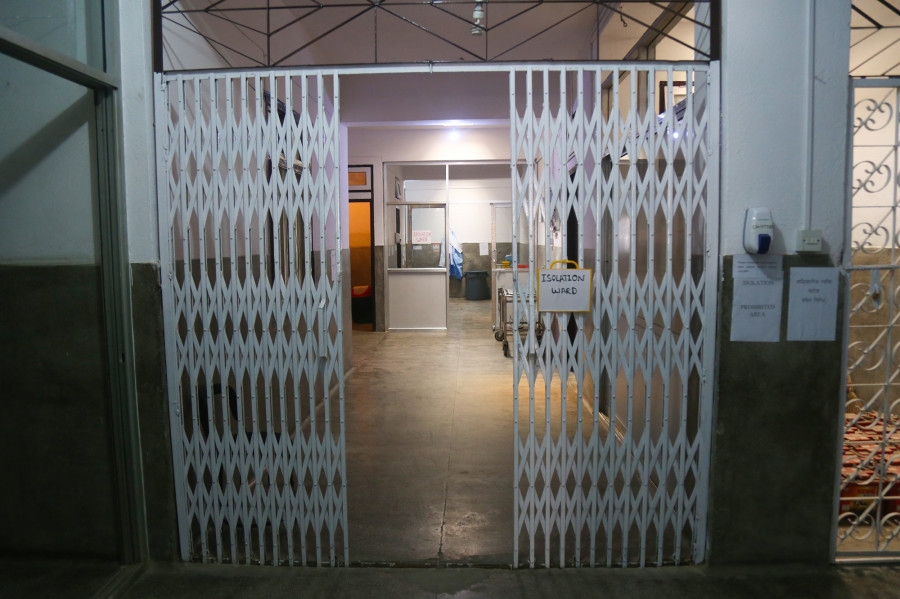Valley
Government to set up 2,000 additional isolation beds in Kathmandu Valley
Health experts suggest converting state-run hospitals into Covid-19 hospitals and pushing preventive measures.
Arjun Poudel
The Ministry of Health and Population is scrambling to arrange isolation beds in Kathmandu Valley as coronavirus infection cases continue to soar by the day.
The ministry plans to set up at least 2,000 isolation beds in the Valley, where 1,794 infections and nine deaths have been reported as of Saturday.
As coronavirus infection is spiralling in the Valley, there have been reports about some infected people getting evicted from their rented rooms and forced to spend the night under overhead bridges and bus stands. Some infected people have started to seek refuge in hospitals. But hospitals are bursting at the seams and unable to isolate patients.
“Those patients who are unable to self-isolate at home will be placed in hospital isolation,” Dr Jageshwor Gautam, spokesperson for the Health Ministry, told the Post. “Those patients who have proper facilities at their homes to observe isolation will be encouraged to do so.”
The number of Covid-19 cases in the country has reached 26,019. On Saturday 468 people tested positive for coronavirus infection and 98 of them were from Kathmandu Valley. The Covid-19 death toll has reached 102.
As the infection numbers rise across the country, health facilities are overstretched. Treatment and management of Covid-19 patients is getting increasingly difficult.
Officials at the Epidemiology and Disease Control Division say they have been dealing with dozens of additional cases that are not accounted for by the Health Ministry during its regular press briefing.
They say many people who have come from outside the Valley are getting infected.
“We have to manage all the cases, which are currently in the Kathmandu Valley,” Dr Basudev Pandey, director at the division, told the Post. “We hope that additional isolation beds will help us in managing the cases for the next few days. If the cases go up at a current pace, additional beds will be required.”
The Department of Health Services plans to set up a 500-bed isolation centre in an apartment complex built for landless squatters in Ichangunarayan. It also plans to build isolation centres at Manmohan Memorial Medical College’s building in Dahachowk, Nepal Electricity Authority’s training center in Kharipati, Ayurveda Campus in Kirtipur and Nepal Medical College.
“We currently have around 400 isolation beds in Kathmandu Valley, only half of them can be used by symptomatic cases,” an official at the Epidemiology and Disease Control Division, said on condition of anonymity.
“According to our estimates, over 150 people are getting infected in the Valley. Guess how many beds will be required in the coming days. We need to act immediately to curb the spread of infection.”
Public health experts say that apart from setting up additional isolation beds, the government should also start converting state-run hospitals into Covid-19 treatment hospitals and focus on preventive measures.
“Beds can be purchased and set up but it will not be so easy to arrange human resources immediately,” Dr Mingmar Gyelgen Sherpa, former director general at the Department of Health Services, told the Post. “To run 500 beds, over 12,000 staff are needed. It will not be easy to hire new staff and train them.”
Sherpa suggests that the government aggressively push for preventing measures and public health safety rules in order to keep the infection rates low.
Some doctors say that lifting of the lockdown in haste is a major reason for the flare-ups in new cases. Over 9,000 new cases have been reported since the end of the lockdown. There were 17,000 cases and 40 deaths across the country until July 21. Infections have been detected in almost all parts of the Kathmandu Valley since.
“Arranging isolation beds in the Valley is a good thing which should have been done a long time ago. But what are we doing in the other districts and in remote places?” said Dr Baburam Marasini, former director at the Epidemiology and Disease Control Division, said. “Preventive measures have not been effective since the beginning, we should focus on it.”




 10.12°C Kathmandu
10.12°C Kathmandu











